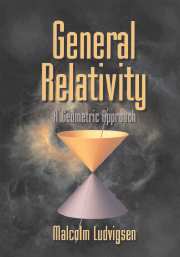16 - Relativistic Cosmology
Published online by Cambridge University Press: 04 June 2010
Summary
Consider a spacetime M that, in addition to its metric gab and its various matter fields, contains a preferred function t (unique up to an additive constant) and a preferred four-velocity vector field va where va∇at = 1. The function t determines a family of hypersurfaces Σt on which t is constant, and va determines a timelike congruence with t as a parameter function. Our intention is to take M as model of the universe as a whole with the hypersurfaces Σt representing different eras, t representing universal time, and the curves of the congruence representing the world lines of comoving particles.
We say that a tensor field is preferred if it can be constructed from nothing more than the available structure on M, that is gab, t, va, and the various matter fields. For example, if a Maxwell field Fab is one of the matter fields, then Ea = Fabvb will be a preferred vector field. Using this notion, we impose the cosmological principle by demanding that the Σt surfaces be isotropic in that they contain no intrinsic, preferred vector fields and hence no preferred directions. This is a very strong condition and implies the following results:
(i) va is orthogonal to Σt. If not, then its projection in Σt would give a preferred vector field in contradiction to isotropy.
(ii) va = ∇at. If va - ∇at ≠ 0, it would be orthogonal to va and hence a preferred vector field in Σt.
(iii) Dva = 0, that is, the world lines are geodesics. If Dva ≠ 0, it would be orthogonal to va and therefore a preferred vector field in Σt.
[…]
- Type
- Chapter
- Information
- General RelativityA Geometric Approach, pp. 182 - 196Publisher: Cambridge University PressPrint publication year: 1999

